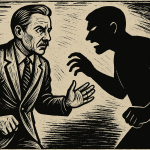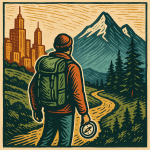Some people say attention is the new currency. Others say it’s the scarcest resource. Here’s a simpler truth: focus is a damn superpower – but like all powers, it can save the world or blow up your kitchen.
The ability to focus is what separates the savage from the scatterbrained. It’s how art gets made, businesses get built, and reps get counted when your lungs are screaming for mercy. But it’s also how people can get tunnel vision and miss the entire point. So let’s talk about that balancing act. How to zero in on the right details without losing the big picture. How to harness this modern-day Jedi mind trick without turning into a hyper-focused lunatic who forgets to eat, sleep, or notice that the house is on fire.
The Savage Science of Focus
Focus isn’t just about sitting still with your jaw clenched and eyes squinting like Clint Eastwood. It’s selective attention. A finely tuned filtration system. It’s your brain saying “this matters” and “this does not” a thousand times a second – and doing it mostly on autopilot.
The problem? Your autopilot was programmed by social media algorithms, childhood trauma, and every open browser tab you’ve ever refused to close. Left unchecked, your focus gets hijacked. You zero in on the wrong things. Like whether your competitor’s font is cooler than yours, or how many likes your last post got instead of whether it was even worth writing.
So the first trick is conscious focus. Choose your target. Pick your battlefield. Then – and only then – unleash hell.
See the Signal, Not the Static
Focus done right is about seeing the important details. The signal, not the noise. The critical brushstroke, not the entire bucket of paint.
Ever watch a chef with real skill? They’re not flailing around tasting everything in sight. They’re checking the texture of the sauce at the exact second it matters. They’ve got a thousand things on the stove but they know when to narrow in on this one pan. That’s focus.
In art, writing, training, building a business, or just showing up for your life – details matter. But not all of them. And not all the time.
So the million-dollar question is: Which details?
Picking the Right Details (and Ignoring the Rest)
This is where the true masters shine. They don’t just focus – they focus on the right things.
A great writer doesn’t stress over every adjective. They zoom in on the emotional trigger of a scene. A great coach doesn’t yell about your pinky toe angle. They correct the one flaw that unlocks everything else.
So how do you know what matters?
- Look for Leverage: Ask, what’s the 20% of input that drives 80% of results? That’s where your focus should live.
- Check the Goalpost: What outcome are you aiming for? If the detail doesn’t move you closer, it’s background noise.
- Track Your Time Sinks: Are you obsessing over fonts, color schemes, or other “productive procrastination”? Focus creep is real.
- Zoom In, Then Out, Then Back In: Like a sniper checking their surroundings. Scan wide, pick your shot, then breathe and pull the trigger.
Lessons from the Trail
Want to sharpen your focus the primal way? Head outside.
Try hiking a rugged trail without paying attention – you’ll end up flat on your face, tangled in thornbushes and wondering why your shins are bleeding. Focus in the outdoors isn’t optional. It’s a survival skill.
Out there, you learn to read the landscape. You scan for trail markers, judge distances, listen for shifts in wind or movement in the brush. But if you only look at your boots, you’ll miss the ridge. The whole point of the climb. That moment where you breathe, look out, and realize why you started.
Hunters know this better than anyone. The best hunters can hold absolutely still for hours, eyes locked, every sense dialed in. But they also track patterns. Weather. Wind. Animal behavior. They don’t just aim – they anticipate. They move between wide awareness and surgical precision like a dance.
Whether you’re stalking elk or hiking to clear your head, the wild teaches a savage lesson: focus is both a microscope and a compass. Know when to zoom in. Know when to take in the whole horizon.

Don’t Miss the Forest
Here’s the danger zone. Too much focus becomes blindness. The artist who spends 8 hours rendering a nose forgets to step back and check if the face even looks human. The entrepreneur who tweaks the landing page for the 47th time forgets to ask if anyone actually wants the product.
This is called detail delusion. It feels productive. It looks smart. But it’s a trap.
You need rhythm. Switch between tight focus and broad perspective. Think of it like camera lenses. Sometimes you need macro. Sometimes wide-angle. The real skill is knowing when to swap.
Practical Applications: The Focus Dance
Writing
Focus on clarity before beauty. Get the idea down. Then zoom into rhythm, voice, and word choice. But don’t rewrite the same paragraph for six hours. Step back. Ask, “Is this piece doing what I need it to do?”
Use Pomodoros if your brain is slippery. Twenty-five minutes of laser mode. Then stand up. Shake it off. Read from a bird’s-eye view.
Making Art
Start rough. Block in shapes and forms. Don’t get obsessed with the eyelashes when the face is still a potato. Move from general to specific. Flip the canvas. Look from across the room. Shift the focus intentionally.
Fitness
Same thing. Don’t hyper-focus on your biceps peak while neglecting your posterior chain. Don’t tweak supplements when your sleep is trash. Zoom out. Are you actually stronger, faster, more mobile than last month? If not, stop optimizing and start executing.
Business & Branding
Don’t sweat the tenth logo version if the brand story is still fuzzy. Don’t obsess over engagement stats if your product solves nothing. Ask what really moves the mission. Then lock in.
The Mental Gym: Training Your Focus
Focus can be trained like a muscle. But it fatigues, too. Don’t expect yourself to be a Zen monk in a Vegas casino without practice.
Here’s your no-nonsense starter kit:
- Box Breathing: Simple, powerful. 4 in, 4 hold, 4 out, 4 hold. Calms the noise so you can actually aim.
- Distraction Audit: What’s pulling your attention? Notifications? Toxic group chats? Cut them like dead weight.
- One-Tab Rule: Multitasking is a lie. One tab. One task. One win at a time.
- Daily “Big 3”: Choose 3 priorities each day. No more. These are your focus zones. Attack them like a lion.
Final Thought: Laser vs Lantern
Focus is a tool. It can be a laser, sharp and deadly. Or a lantern, wide and illuminating.
The real flex is knowing which one to use and when.
When you’re creating? Laser. When you’re planning or re-evaluating? Lantern.
When you’re executing? Laser again. When you’re reflecting, zoom out and let the forest reveal itself.
Remember, a savage mind isn’t just focused — it’s agile. It dances between vision and detail, mission and moment. That’s how art gets made. That’s how empires get built.
So sharpen the blade. But don’t forget to scan the battlefield.






Comments by The Dapper Savage